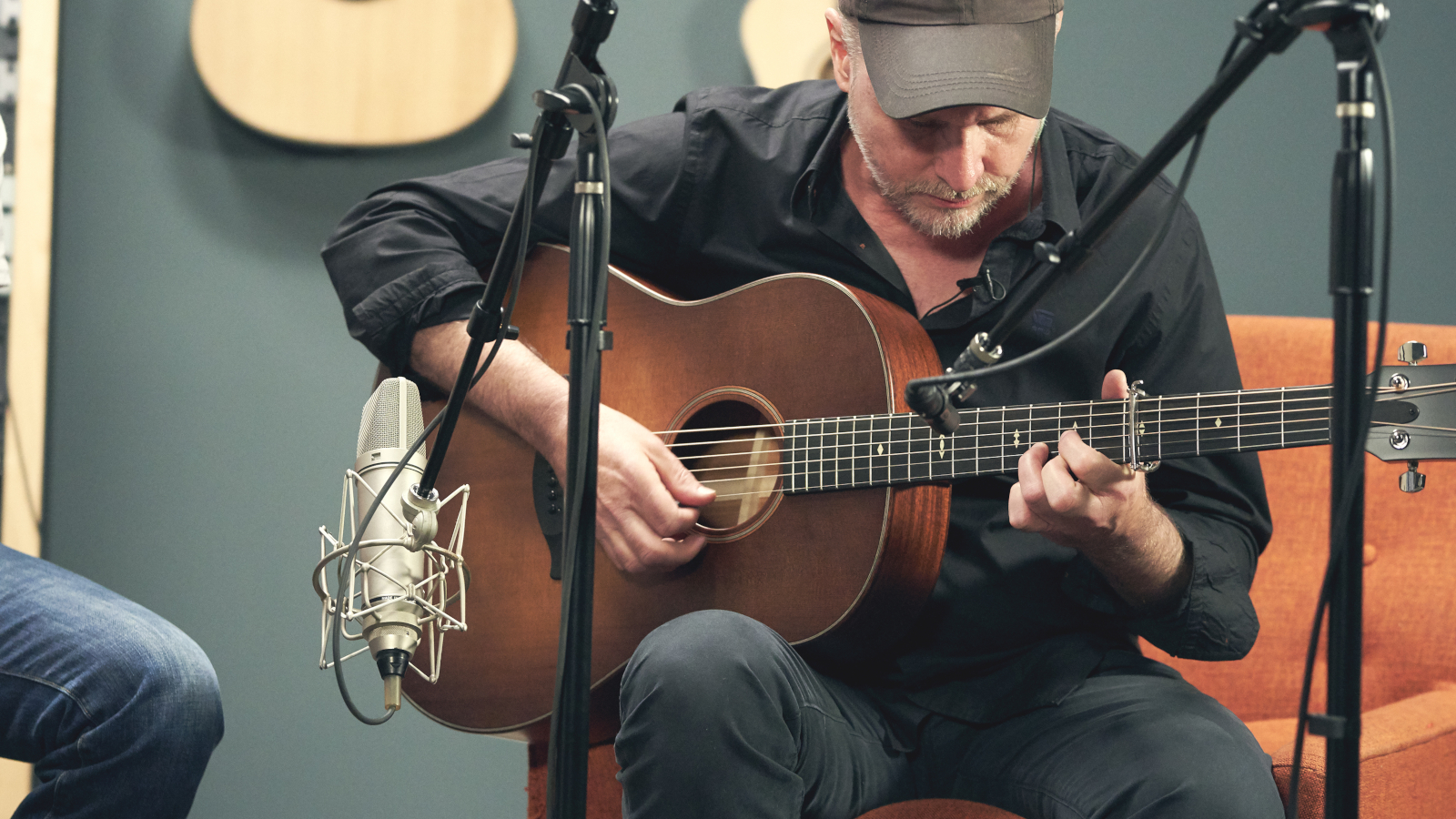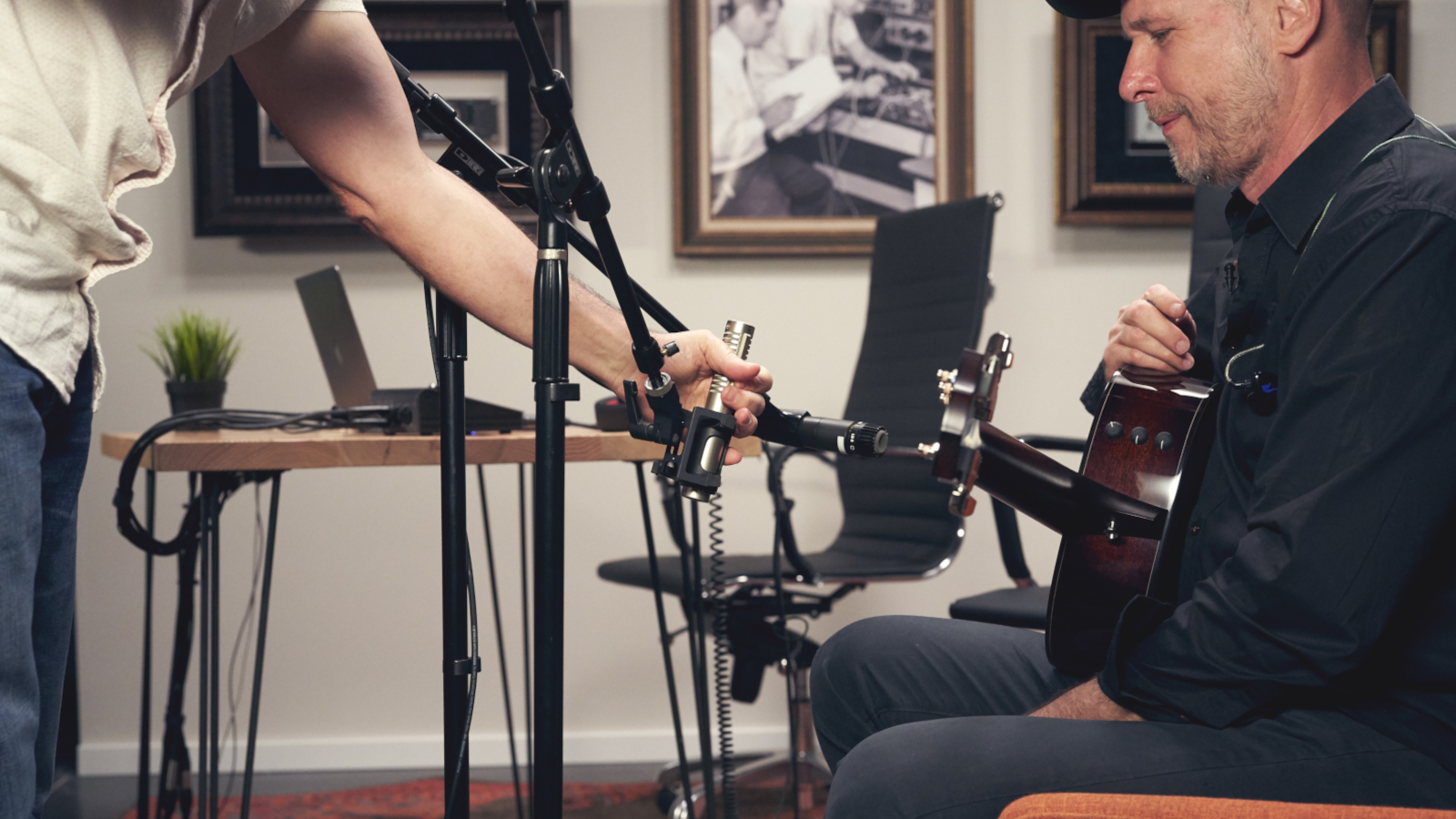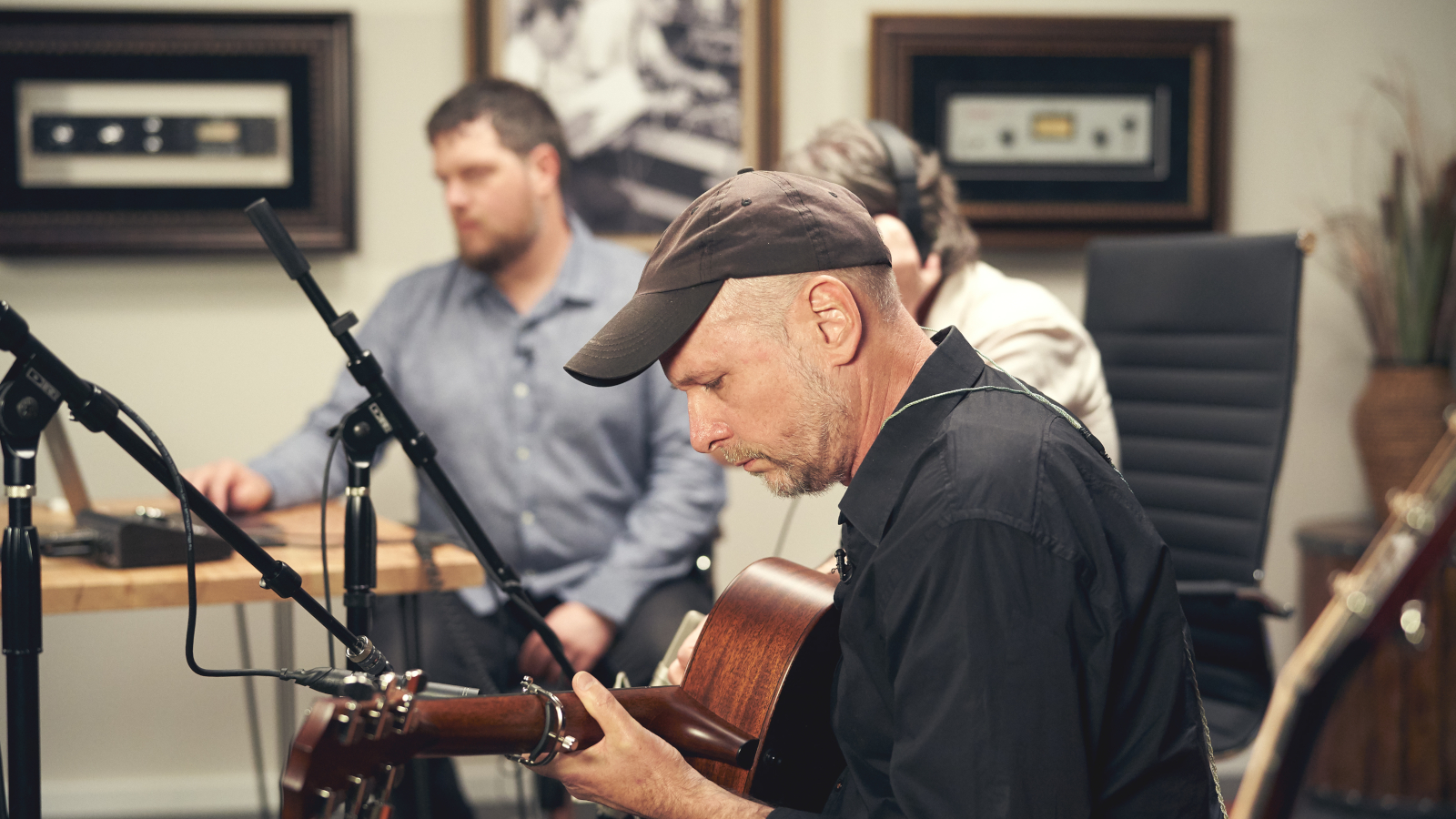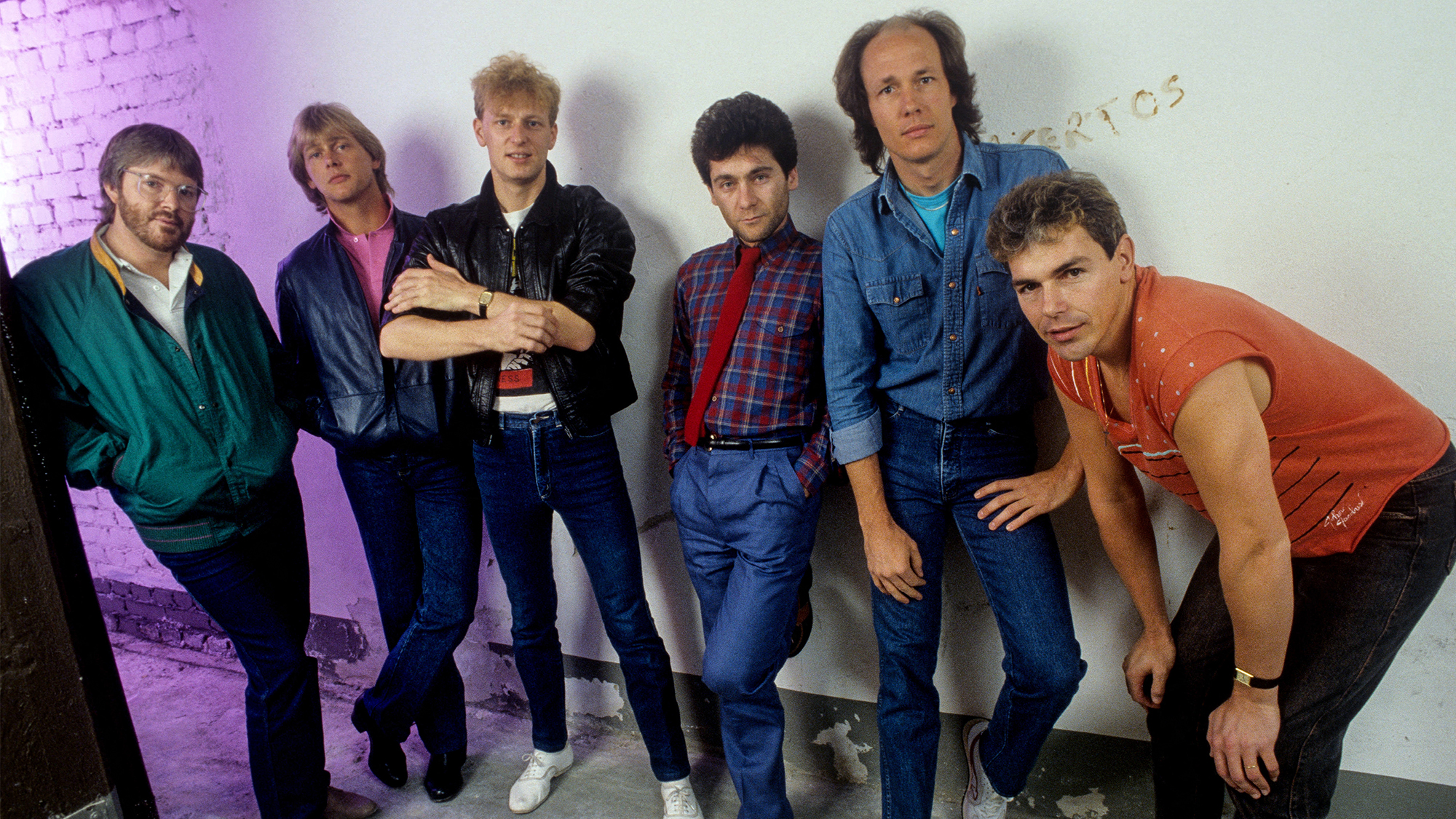Get Some Acoustic Guitar Recording Tips from a Nashville Studio Master
Session ace Jerry McPherson delivers deep insights from guitar and microphone choices to some curious advice on string maintenance.

Jerry McPherson still gets the kind of Nashville session calls that dried up for most players many moons ago.
When called upon, he can help an established artist land a hit, or use his extensive experience to guide a less experienced player to a particular guitar-based musical vision.
McPherson’s credits include countless sessions for superstars such as Faith Hill, Kelly Clarkson and Tim McGraw, as well as many other artists.
One of the lauded producers who counts on his fleet fingers is Grammy winner Jacquire King (Tom Waits, Kings of Leon). The two recently teamed up for Universal Audio to make an in-depth Tones & Techniques video (see below) about tracking acoustic guitars, and every reader even remotely interested in recording should take a serious look at it.
In the clinic, hosted by UA’s Ben Lindell, King and McPherson go beyond making suggestions about mic technique, guitar selection, direct signals, plug-ins and other recording gear.
They reveal why they might choose a certain pairing for one situation and a completely different signal chain to yield another sound in three distinct genres: singer-songwriter, roots-blues and pop-rock.
It’s fascinating to watch the process from both sides of the equation, with King going deep down the engineering rabbit hole and McPherson offering his insights in real time.
All the latest guitar news, interviews, lessons, reviews, deals and more, direct to your inbox!
Lindell assists by clearly displaying the A/B comparisons that the producer and player demonstrate.
McPherson is like a stylistic Swiss Army knife, and his extensive electric guitar background informs his acoustic approach.
He’s a Taylor man, and he plays Taylor guitars throughout the video, but he is also a vintage-guitar lover.
In the following interview, McPherson expounds on topics such as when to go for a vintage vibe and when to stay contemporary. He also demonstrates how to make a modern instrument sound more classic, approach ensemble and solo acoustic recordings, and make the most of a studio situation using practically any microphone and acoustic guitar.

What’s a day in the life of a Nashville session player like today?
It’s a shame that there aren’t as many session gigs available as there used to be, but there’s still an industry here with tracking to be prepared, so it’s still fun. Record labels used to record so much music here, but now it’s kind of the Wild West. A lot of artists come in on their own, representing themselves.
I’m actually just getting ready to go in and do a day of tracking. I have no idea what we’ll be doing. You never know ahead of time; that’s normal.
The unusual aspect about the past few days is that I did a three-day project with the same artist at the same studio, which is rare. In this case it was a fabulous singer from Connecticut recording at Sound Emporium, which is a legendary studio.
Record labels used to record so much music here, but now it’s kind of the Wild West
Jerry McPherson
What acoustic guitars do you typically take along to a session?
I’ll bring a few different kinds of guitars, including one nice dry-sounding older acoustic. Lately, I’ve been bringing a 1964 Harmony Sovereign dreadnought. Jimmy Page used a Sovereign on “Stairway to Heaven.”
James Burkett is a builder in Alabama who redoes the bracings on old Harmony Sovereigns from the early ’60s and makes them sound fabulous. He refurbished mine. It’s a great old instrument with plenty of vibe.
I also bring a couple of newer Taylors along, not only because I have a Taylor endorsement but also because a lot of younger artists are accustomed to playing and hearing them.
There have been times when I’ve played the artist’s acoustic, which could be anything. I like to bring my Taylor 522 because it’s a 12-fret with mahogany back and sides and a cedar top, which is a warmsounding wood combination, and the positioning of the bridge further from the soundhole gives it a different resonance than a 14-fret. I’ve got a 614 with V-Class bracing that plays so well, with such great intonation.
Any guitar that will play in tune is a friend in the studio, and a guitar that’s wonderfully in tune with itself goes up a notch in value as far as the way it resonates on the mic.
It’s also nice to have a newer guitar on hand because I can count on consistency with no mechanical issues or buzzes.

Is that the full arsenal of sizes and styles?
All the Taylors are Grand Auditorium body styles – no parlors or jumbos.
In addition to having a nice vintage guitar, the V-Class Taylor for a modern brighter sound, and the 12-fret for a different voice, I might bring some other things for textural overdubs, such as a gutstring.
I’ve got a Goldstone Irish bouzouki set up for guitar tuning, and I have a 1980 Martin M-38 set up for high-strung tuning. Sometimes I use standard Nashville tuning, but I also like to retune it randomly to fit the song, and then find an arpeggiated, repeating pattern that I can pick through on the chorus.
Another thing I’ll do with that guitar is tune it to all tonics, 2nds and 5ths for whatever key the song is in, so that I’m not committed to anything major or minor, and then find some nice little figure for the intro.
I typically go for more of a vintage vibe, because I’m not keen on sparkly acoustics
Jerry McPherson
What instrument do you tend to gravitate toward first?
I typically go for more of a vintage vibe, because I’m not keen on sparkly acoustics. That might work for a solo project, but engineers don’t like acoustics that take up so much space in an ensemble.
I’ve gone to great lengths to deaden the strings on some of my guitars so that they are not bright.
Such as?
Okay, so here’s the deal. Years ago I bought a Gibson J-45 from the ’60s that had old strings on it. Engineers would say things like, “Thank you for not having some bright, scrapey-sounding acoustic. I can actually find a spot for this in the track.”
I started thinking about what was going to happen once I finally needed to change those strings.
I’ve got Guitar Player magazines dating back to the ’70s, and I started reading through them. I remember an article where Stephen Stills said he would rub barbecue sauce into his strings. I’m not doing that, I thought, but I started experimenting.
I made a paste out of waterproof sunscreen and fireplace ash. I’d take a set of GHS Vintage Bronze strings out of the package, rub that paste all in them, and then let them dry overnight. After rubbing it out with a T-shirt, the strings would sound like they were three years old.
At a NAMM show, I told that story to the president of GHS Strings, and he said, “I think that’s the weirdest thing I’ve ever heard!”

That is a weird one! Couldn’t you get similar results simply by using coated strings?
I’m not really into strings that have that dental floss rubbed in them. It feels like my fingers are going to slip off coated strings, and I need that grip.
How about mics?
For a solo acoustic track, I’d be much more likely to use a pair of mics that could be spread out in the stereo field, but that loses its appeal in an ensemble track, which is the vast majority of work that I do.
The general approach is to use a single mic and do two mono passes that are ultimately doubled up, one right on top of the other. I always defer to the engineers here in Nashville, because most of them are so skilled. Trust a good engineer and you’ll probably learn something.
Left to my own devices and my own mics, I will usually start with an AKG C414, which is a condenser mic with a larger diaphragm and a variable polar pattern. That’s a matter of how much you want it to pick up the sound right in front of you, to the left and right, and also around its back to capture more room ambiance.
Left to my own devices and my own mics, I will usually start with an AKG C414
Jerry McPherson
What other mics do you like for acoustic guitar?
Ribbon mics. I have a Royer and a Coles, and I love the way I can manipulate their sounds with equalization to make an acoustic fit just right in a track. For whatever reason, they seem to take equalization better than condensers.
A large-diaphragm condenser will deliver a full spectrum, with plenty of air in the top end, although not as much of a silky top as a small condenser like a Neumann KM 84.

But I want the top end of an acoustic to sit in the upper mids, below the range of vocal sibilance and cymbals. It’s a common complaint in Nashville that acoustics and hi-hats clash because they sit in the same sonic area.
I think that’s where my magic string paste helps. It tames some of the high end for more vibey, darker types of music. And I think some engineers have moved to ribbons mics for acoustic guitars to get away from the super top end that interferes with other instruments.
I want the top end of an acoustic to sit in the upper mids, below the range of vocal sibilance and cymbals
Jerry McPherson
How can incorporating a direct signal from an acoustic-electric help?
I use it to help dial in the midrange and add immediacy to the signal. It can also be helpful for experimenting with effects that react differently to a direct signal than a microphone in a room with its own ambience.
How does technique, such as fingerstyle compared to picking, factor into the tonal equation?
I’m the first one to tell people that if there’s going to be a lot of fingerpicking involved, you might want to get a real fingerpicker, because there’s not much middle ground. You’re either fantastic at the technique, and the tone is there, or you’re kind of a hack, which is what I consider myself.
But I will put in the time to work on an essential fingerpicking part if an artist sends me a work tape. Like a crossword puzzle, there’s a certain charm to working it out and arriving at a point where the notes are even, without sounding mechanical. There’s a real beauty to be found.
Sometimes I’ll purposely monitor my playing with too much compression, in order to accentuate any weird noises that I need to go back and fix.

What’s your pick of choice?
My main pick is a Dunlop Nylon 88mm. It has just the right amount of stiffness versus flexibility, and I’ve developed my style around its snappy, quick return.
I’ll use a thinner 50mm red Dunlop Tortex for a more wispy sound, and a thicker 1mm blue Dunlop pick for emulating fingerpicking rolls without having too much pick click going on. The thicker pick is good for a more buttery sound.
Got any tips on what to do before the end of a session?
I always get some visual cues on where my acoustic is positioned in the room. The worst thing that can happen is you pack up your stuff thinking you’re done, and then you go into the control room and they say, “Hey, let’s try that second verse again.”
So you go back into the studio, they punch you in – and it’s not the same sound. That’s why I never move the chair I’m using. When I get up, I get out of it gingerly, and I take visual notes about where the guitar neck is pointing, such as toward an electrical outlet.
I’ll also make actual notes regarding its proximity to the microphone. I’ll use a pencil to measure the distance from the microphone to the guitar and scoot it toward the guitar until the eraser touches it, so I know the exact location of the sweet spot in case we need to go back and track again.
Jimmy Leslie is the former editor of Gig magazine and has more than 20 years of experience writing stories and coordinating GP Presents events for Guitar Player including the past decade acting as Frets acoustic editor. He’s worked with myriad guitar greats spanning generations and styles including Carlos Santana, Jack White, Samantha Fish, Leo Kottke, Tommy Emmanuel, Kaki King and Julian Lage. Jimmy has a side hustle serving as soundtrack sensei at the cruising lifestyle publication Latitudes and Attitudes. See Leslie’s many Guitar Player- and Frets-related videos on his YouTube channel, dig his Allman Brothers tribute at allmondbrothers.com, and check out his acoustic/electric modern classic rock artistry at at spirithustler.com. Visit the hub of his many adventures at jimmyleslie.com
